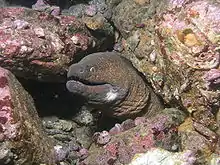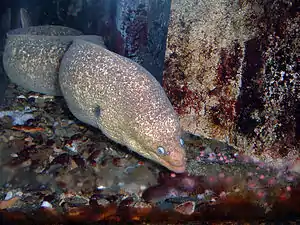California moray
The California moray (Gymnothorax mordax) is a moray eel of the family Muraenidae, found in the eastern Pacific from just north of Santa Barbara to Santa Maria Bay in Baja California.[1] They are the only species of moray eel found off California, and one of the few examples of a subtropical moray. They typically occupy boulder or cobble habitats up to 40 m in depth.[2] They can attain lengths of about 5 ft (1.52 m) and are believed to live for upwards of 22–26 years.[3] Like other morays, they have no pelvic or pectoral fins or gill covers.
| California moray | |
|---|---|
 | |
| Scientific classification | |
| Kingdom: | Animalia |
| Phylum: | Chordata |
| Class: | Actinopterygii |
| Order: | Anguilliformes |
| Family: | Muraenidae |
| Genus: | Gymnothorax |
| Species: | G. mordax |
| Binomial name | |
| Gymnothorax mordax (Ayres, 1859) | |
Habitat and Distribution
California morays are a common sight on rocky reefs surrounding islands in southern California (notably, Catalina Island in the California Channel Islands) and other islands in the Pacific.[1] However, at least one study has proposed that this species is non-reproductive in the most northern parts of its range due to the water temperature being too cold for gonadal development.[4] A more recent study aged morays from Catalina Island using their otoliths (ear bones) and found that the majority of individuals examined likely arrived on Catalina Island during an El Niño Southern Oscillation (ENSO) event,[3] supporting the hypothesis that spawning populations are found further south. During an ENSO event, the southward-flowing California Current slows down and moves offshore, allowing the northward-flowing Davidson Current to bring leptocephalus larvae to northern areas.
California moray juveniles live in tide pools while adults live in deeper waters.[5] Morays also have high site fidelity, generally remaining in one cove over a long time.[2]
Feeding behavior
California morays mainly eat fish, although they are opportunistic predators whose diet also consists of invertebrate prey such as octopuses, lobsters, and shrimp. Interestingly, it appears that California morays will share habitat space with potential prey species, including both shrimp and lobsters.[6] Although most fishes living in open environments can open their mouths wide enough to suck in prey, the small space the moray lives in prevents it from catching prey this way.[5] Like other morays, California morays have a special set of pharyngeal jaws that allows prey to be transported from their mouths into their throats. As an additional aid to prey transport, they have a set of depressible teeth in the roof of their mouths that fold upward as prey is swallowed.[7] They are considered a nocturnal hunter, due to their elusiveness in the daytime.[2] The California Moray is thought to be primarily piscivorous, and appears to specialize in the kelp bass, Paralabrax clathratus.[8]
No relationship has been found between prey size and moray size, suggesting that California morays will continue to eat small prey even as they themselves get larger.[7] They are apex predators in the reef, with few predators of their own. California morays are not commercially fished.
 California moray
California moray California moray
California moray California moray
California moray
References
- Fitch, John E.; Lavenberg, Robert J. (1971). Marine Food and Game Fishes of California. University of California Press. ISBN 9780520018310.
- Higgins, B. A.; Mehta, R. S. (2018-01-01). "Distribution and habitat associations of the California moray (Gymnothorax mordax) within Two Harbors, Santa Catalina Island, California". Environmental Biology of Fishes. 101 (1): 95–108. doi:10.1007/s10641-017-0684-0. ISSN 0378-1909. S2CID 24614235.
- Higgins, B. A.; Pearson, D.; Mehta, R. S. (2017-01-31). "El Niño episodes coincide with California moray Gymnothorax mordax settlement around Santa Catalina Island, California". Journal of Fish Biology. 90 (4): 1570–1583. doi:10.1111/jfb.13253. ISSN 0022-1112. PMID 28138961.
- "The ecology and behavior of the California moray eel gymnothorax mordax (Ayres, 1859) with descriptions of its larva and the leptocephali of some other east pacific muraenidae :: University of Southern California Dissertations and Theses". digitallibrary.usc.edu. Retrieved 2018-05-09.
- "California moray (Gymnothorax mordax)". Monterey Bay Aquarium. Retrieved November 2020. Check date values in:
|access-date=(help) - Poulin, Robert; Grutter, Alexandra S. (1996). "Cleaning Symbioses: Proximate and Adaptive Explanations". BioScience. 46 (7): 512–517. doi:10.2307/1312929. JSTOR 1312929.
- Harrison, Jacob S.; Higgins, Benjamin A.; Mehta, Rita S. (2017-06-01). "Scaling of dentition and prey size in the California moray (Gymnothorax mordax)". Zoology. 122: 16–26. doi:10.1016/j.zool.2017.02.002. ISSN 0944-2006. PMID 28236504.
- Higgins, Benjamin, A. (2018). "Functional Ecology and Metabolics of the California Moray ( Gymnothorax mordax)". Retrieved November 2020 – via ProQuest. Check date values in:
|access-date=(help)
- Froese, Rainer and Pauly, Daniel, eds. (2006). "Gymnothorax mordax" in FishBase. June 2006 version.
External links
- Photos of California moray on Sealife Collection
